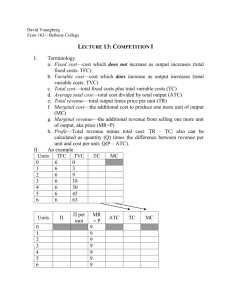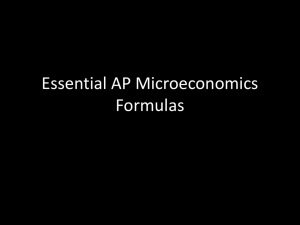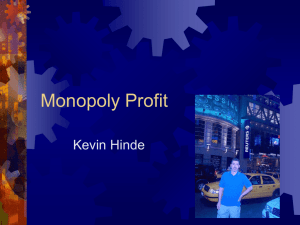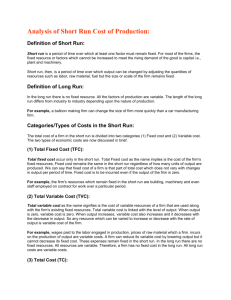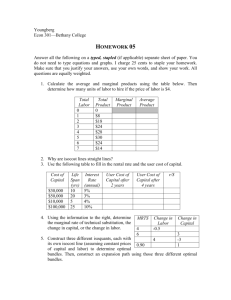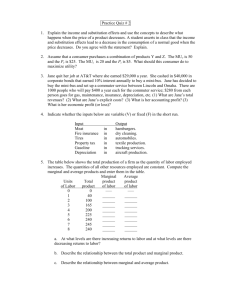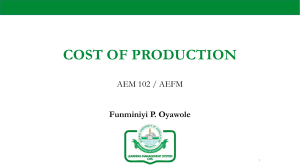TC / ∆ Q
advertisement
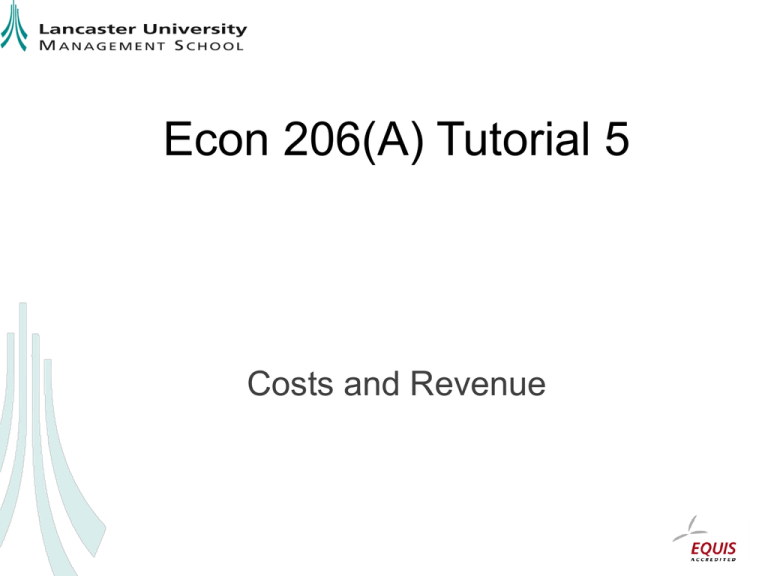
Econ 206(A) Tutorial 5 Costs and Revenue Cost Concepts 1. Fixed Costs. Do not vary with output (rent, plant etc) 2. Variable Costs. Vary with output (wages, raw materials etc) 3. Total Cost = Fixed Cost + Variable Cost Totals, Averages and Marginals • Total Cost (TC) = Average Cost (AC) * Quantity Produced (Q) • Average Cost (AC) = Total Cost(TC)/Quantity(Q) • Marginal Cost = The extra cost of producing one or more additional units of output. MC = ( ∆TC / ∆ Q ); or MC = ( TCQ2 – TCQ1 ) Seminar Topic 1 1. Show How a Firms Short-run and Long-run Cost Curve Can be Derived From its Isoquant/Isocost Map Output Expansion Path (long run) Capital (K) The output expansion path can be used to derive long run costs! C2 > C1 > C0 Output Expansion Path b c Q2 > Q1 > Q0 a Q2 Q1 Q0 C0 C1 C2 Labor (L) Long Run Total Cost Curve Cost c LTC C2 b C1 a C0 Q0 Q1 Q2 Output (Q) Output Expansion Path (short run) Capital (K) In the short run, K is constant. Diminishing MPL C2 > C1 > C0 Output Expansion Path Q2 > Q1 > Q0 a b c Q1 Q2 Q0 C0 C1 C2 Labor (L) Short Run Total Cost Curve Cost STC c C2 LTC b C1 a C0 Q0 Q1 Q2 Output (Q) Total Costs - Numerical Output (Q) TFC (£) TVC(£) TC(£) 0 10 0 10 1 10 8 18 2 10 14 24 3 10 19 29 4 10 27 37 5 10 40 50 Total Costs = TFC+TVC 50 45 40 35 Cost 30 TFC (£) 25 TVC(£) TC(£) 20 15 10 5 0 1 2 3 4 Quantity 5 6 Average and Marginal Costs Output (Q) TC (£) AC(£) MC(£) 0 10 1 18 18 8 2 24 12 6 3 29 9.67 5 4 37 9.25 8 5 50 10 13 Seminar Topic 2 • Distinguish Between Internal and External Economies/Diseconomies of Scale. Economies of scale • Internal: – Decreases in the cost of production (increase in productivity) as output (q) of firm increases. • External: – Decreases in cost of production (increase in productivity) as output (q) of industry increases. – Examples: • Improved transport and communication links. • Training and education becomes tailored to the industry (i.e. improved quality workers). • Development of support firms and industries. Revenue • Total Revenue (TR ) = Quantity sold times price; P x Q • Average Revenue (AR) = TR/Q; (in perfect competition this is P.) • Marginal Revenue (MR) = MR = ( ∆TR / ∆ Q ). Revenue Q TR AR MR 1 8 8 8 2 15 7.5 7 3 21 7 6 4 26 6.5 5 5 30 6 4 Seminar Topic 3 • Explain Why Marginal Costs Must Equal Marginal Revenue for Profit Maximisation. Profit Maximisation • Profit (P )= TR – TC • Largest when MR=MC. • Intuition: – If MC>MR then TC is increasing quicker than TR. Hence profit is decreasing. – If MR>MC then an increase in Q will increase TR more than TC. Hence profit could be increased by producing more. Profit Maximisation Rule – Numerical Example Q MR MC TR TC Profit 1 8 6 8 6 2 2 7 6 15 12 3 3 6 5 21 17 4 4 5 6 26 23 3 5 4 7 30 30 0 Profit Maximisation Rule – Numerical Example (slight variant MC=MR) Q MR MC TR TC Profit 1 8 6 8 6 2 2 7 6 15 12 3 3 5 5 20 17 3 4 5 6 25 23 2 5 4 7 29 30 -1
